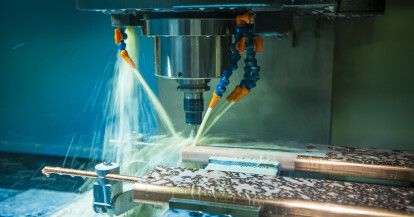Machinability of metals. Is copper a ductile?

Much depends on the chemical composition and structure of metals. These characteristics affect their mechanical and thermal strength, as well as the susceptibility of individual materials to various types of machining. One of these is machining, or the removal of excess material. We explain what the susceptibility of metals to machining depends on and what the machinability indexes of materials are.
Machining and machinability of metals
Metals can be machined by many methods - such as casting, welding and machining. Machining involves removing successive layers of machining allowance and converting it into chips using appropriate tools.
Machining can be divided into two types of machining, which differ in the size and number of blades in the tools:
- chip machining (e.g. turning, drilling, milling);
- abrasive machining (e.g. grinding, honing).
Machinability, on the other hand, is an indicator of the susceptibility of a particular material to cutting, by which we obtain the desired properties of the machined surface. Machinability, in turn, is the ability of a particular tool to cut another metal.
Machinability is determined by such material properties as its chemical composition and structure, which is influenced by the technology of manufacturing and preparing the metal for machining. Yield strength, hardness, heat conductivity and other material characteristics depend on these factors.
Why is determining the metal's machinability important for industrial production? Thanks to this parameter, we know what workpiece materials to use to achieve the desired machining time and increase productivity. This, in turn, leads to a reduction in the cost needed to manufacture metal components.
Material machinability indices
Material machinability indices
- cutting resistance - these are determined by cutting forces, cutting power and cutting torque, which are relevant to the strength of tools and machine tool components and the energy required to remove the machining allowance in a certain amount;
- the quality of the machined surface - it is related, among other things, to the roughness of the metal being cut;
- the life of the blade at an assumed cutting speed, or the periodic cutting speed at an assumed blade life;
- the shape of the chips produced in the cutting process - this affects the risk of damage to the machining tool and the material being cut, as well as the risk of causing an accident at work; it is also related to the cost of chip storage and handling.
It is not possible to unambiguously determine the order of machinability indicators in terms of their importance - depending on the type and degree of automation of machining, other indicators may gain in importance. For example, in rough machining, the most important criteria are cutting resistance and blade life, and in fine machining - the quality of the surface after machining.
In addition to this, we also distinguish a number of absolute machinability indexes that allow us to select the right metal in terms of the best cutting parameters:
- coefficient of friction,
- amplitude and frequency of vibration,
- mechanical properties of the metal,
- chip breakage coefficient,
- temperature in the cutting zone.
Machinability of copper and its alloys
Pure copper is considered difficult to cut - it forms long and difficult to evacuate chips. Its alloys are much more machinable. For example, for automated production, copper with the addition of lead is well suited - the chips are then brittle. Brass, an alloy of copper and zinc, is also a material with favorable machinability rates. The more zinc, the lower the surface roughness of the cut part.
An alloy that also achieves low roughness is bronze - a combination of copper and tin or other metals (copper content of 80-90% by weight). The machined surface properties of bronze are particularly well influenced by high cutting speed.
Why do copper alloys show good machinability? On the surface of some materials, overgrowths (sticking) form during cutting, through which the forces and temperature in the machining process increase, and as a result, the resulting surface does not have satisfactory properties. In the case of copper alloys, such a problem does not occur, so cutting is carried out efficiently and effectively - both in chip and abrasive machining.
If copper has such alloying additives as lead, selenium or tellurium, chip breakage and cutting forces are lower, and the temperature accompanying the machining process is lower. All this ultimately leads to even better machinability.
How do we perform machining at Electris?
Copper machining at Electris is one of the processes we offer to our customers. By machining copper and its alloys by means of milling or turning, we obtain very good cutting parameters and, consequently, the appropriate properties of the machined components.
Other technologies we offer at Electris are:
- CNC punching,
- CNC bending,
- water jet cutting,
- grinding,
- threading,
- pressing of components,
- soldering,
- engraving,
- embossing,
- marking.



